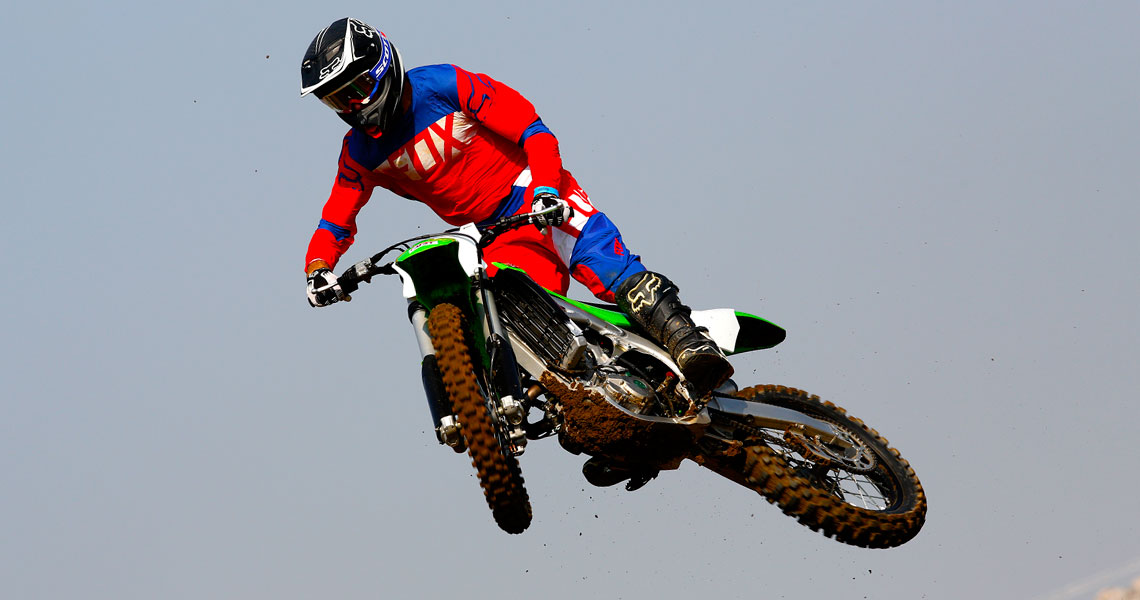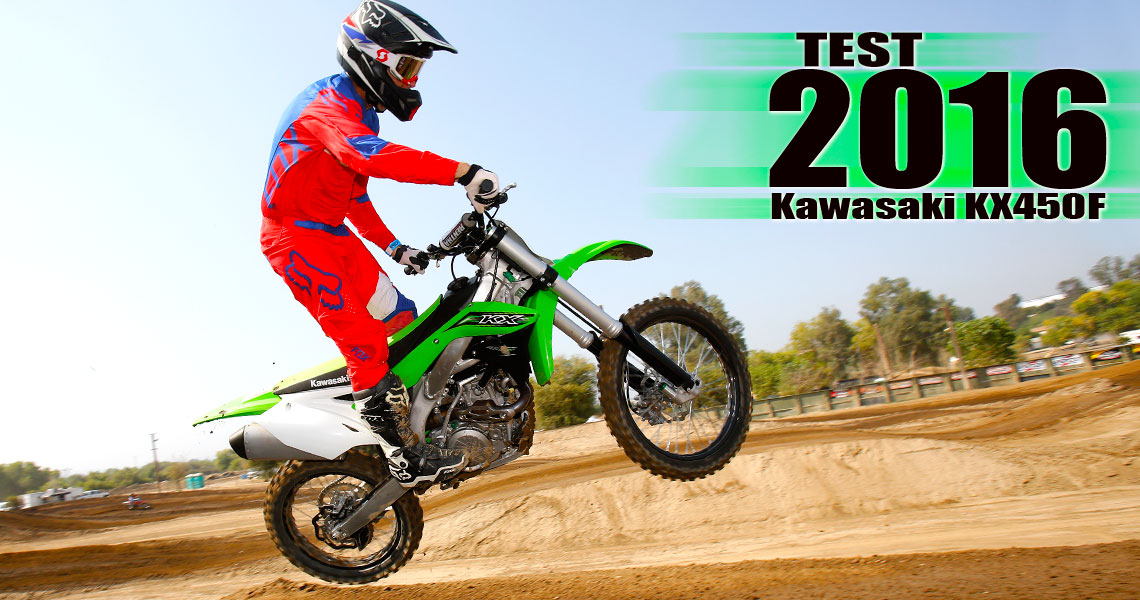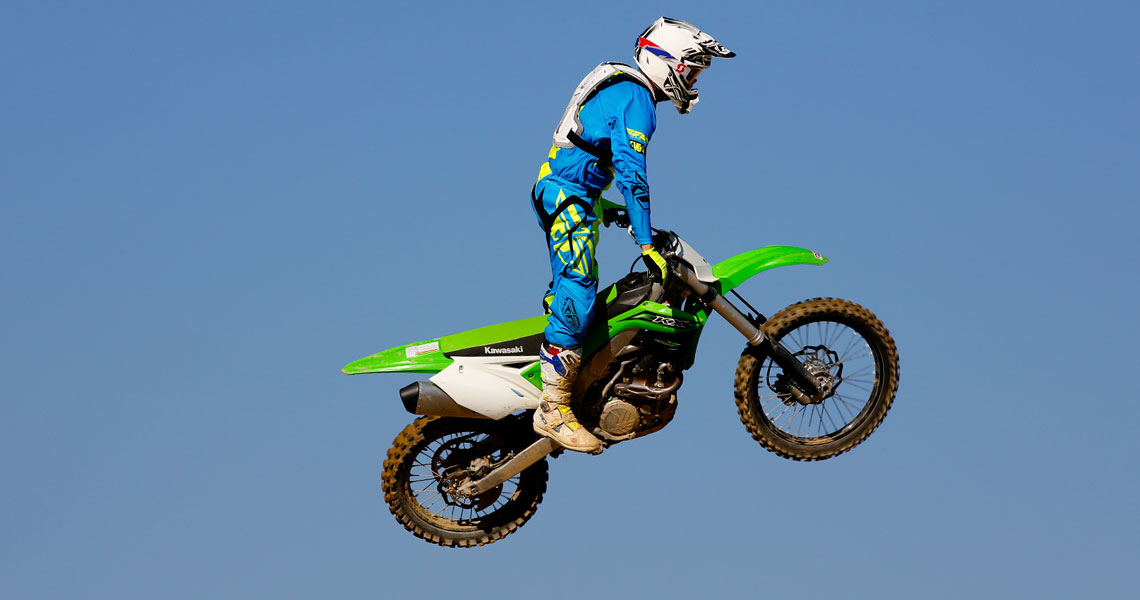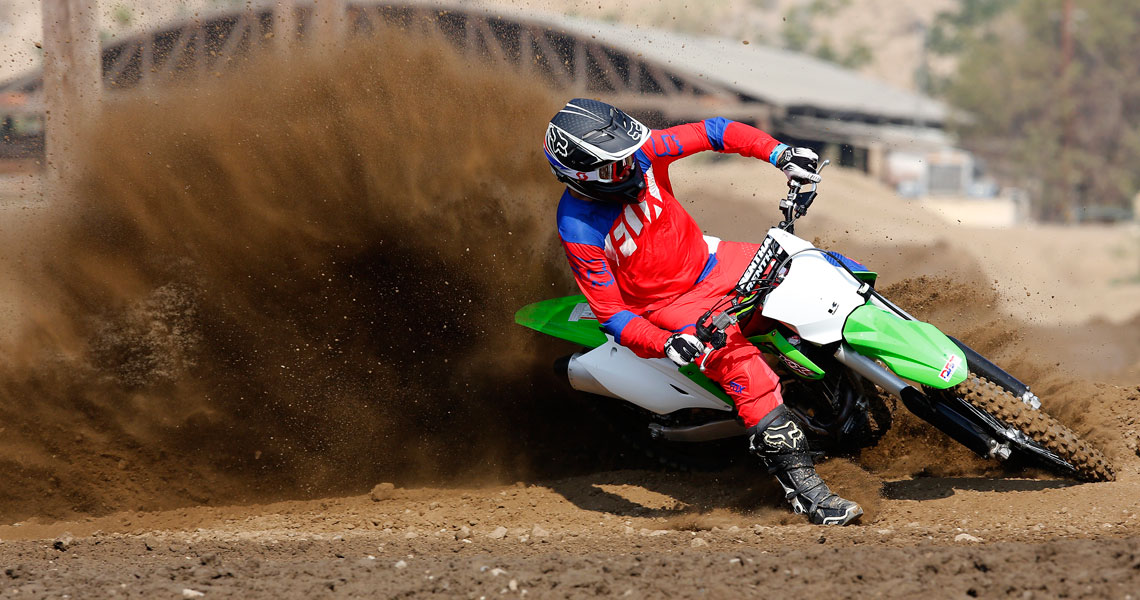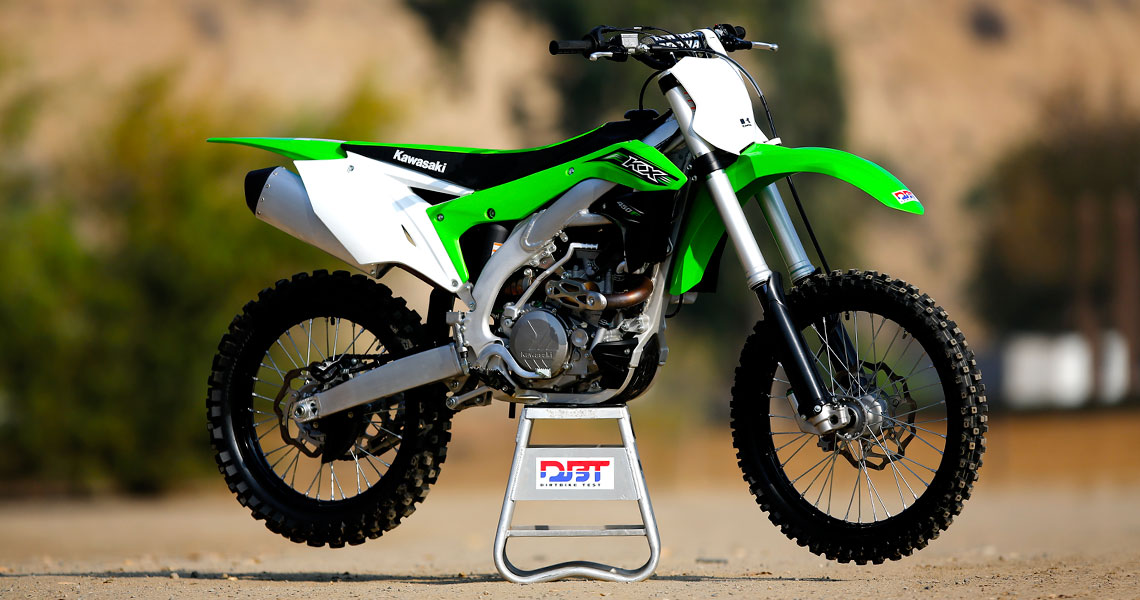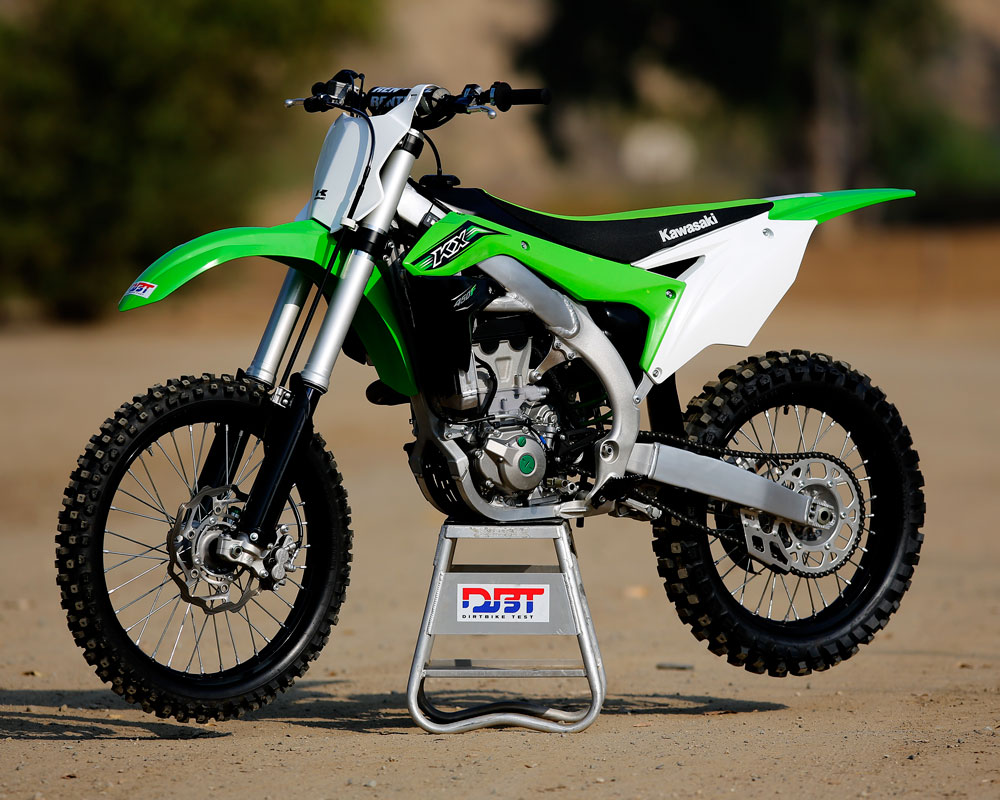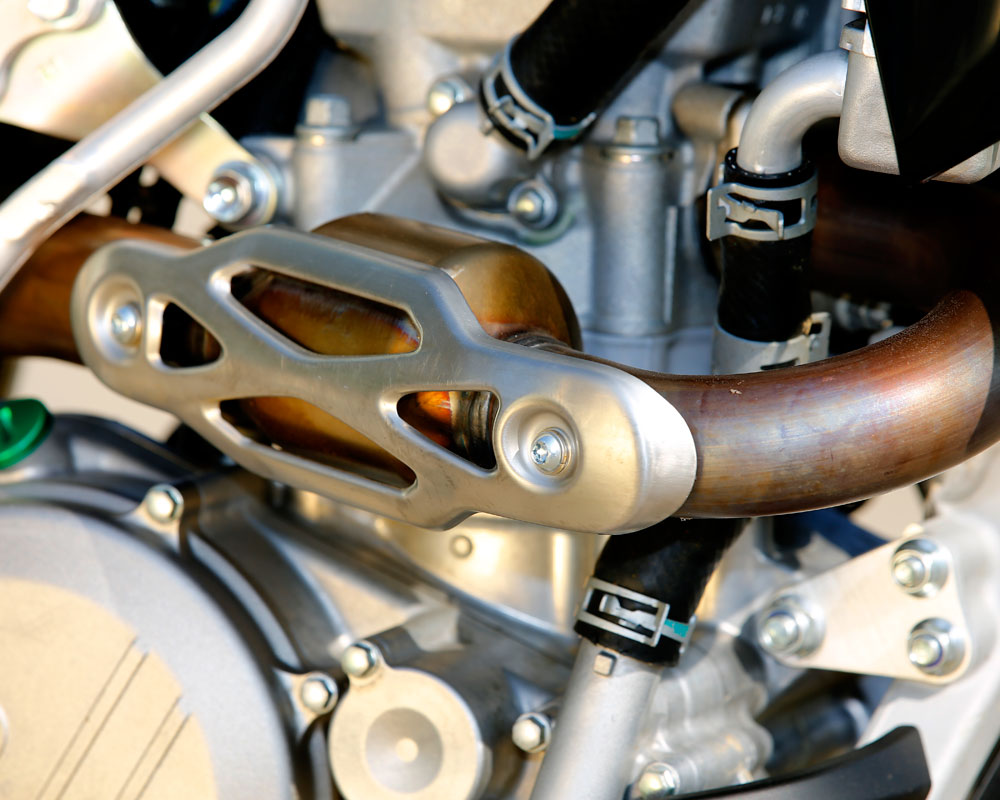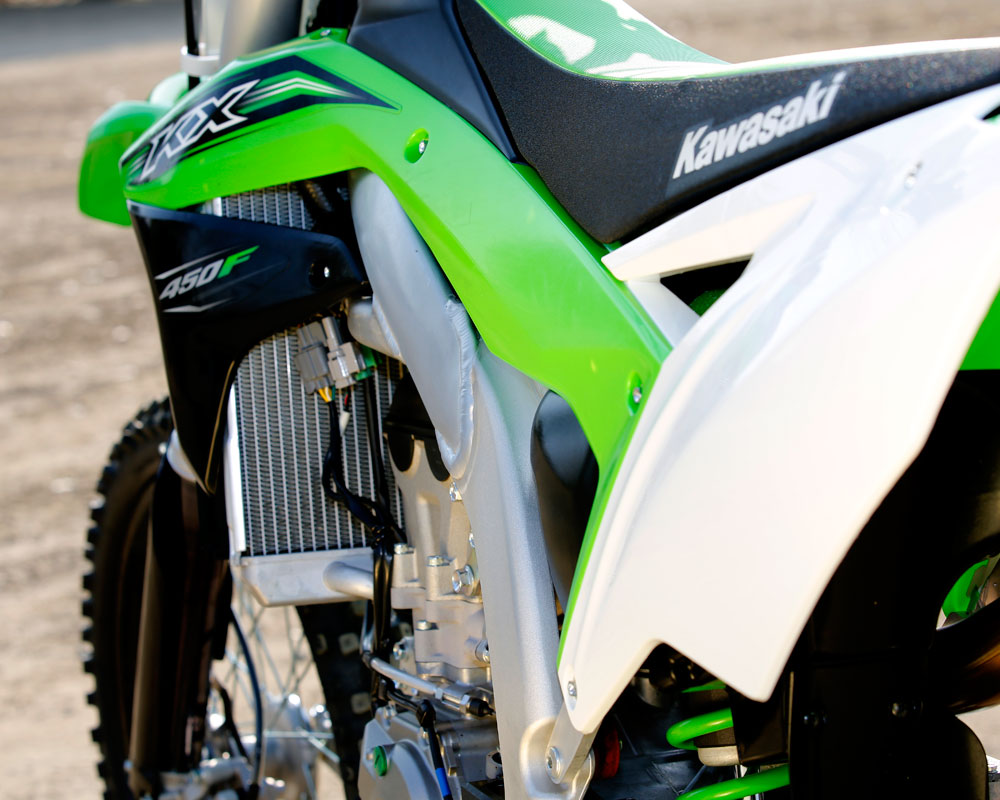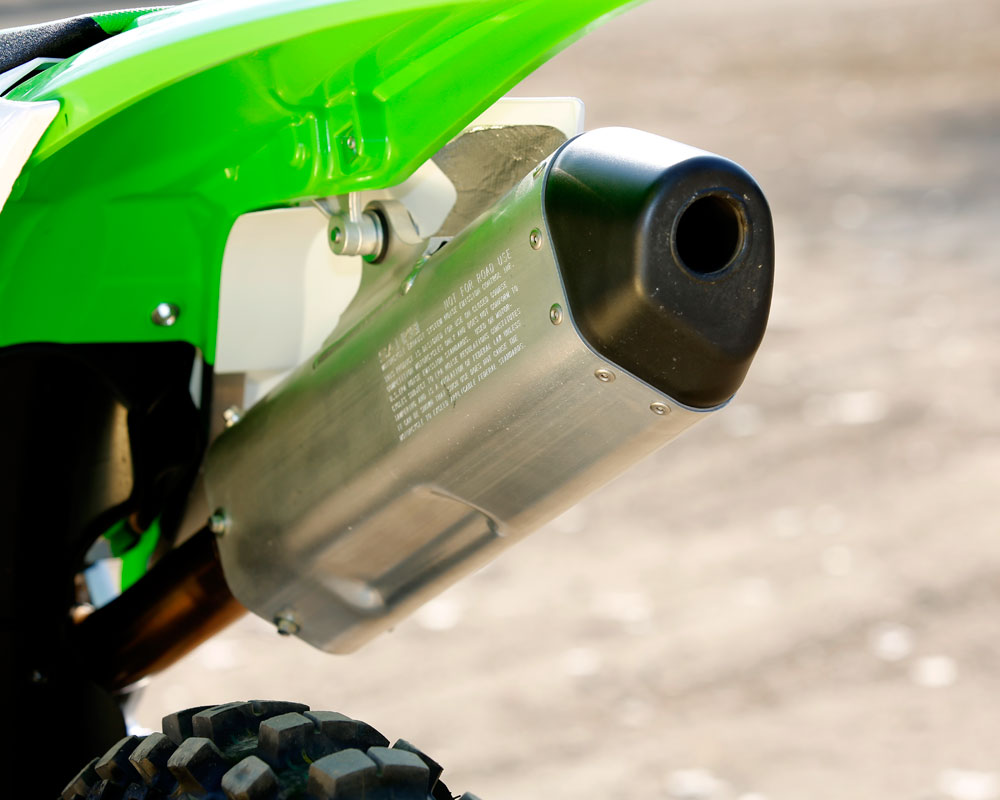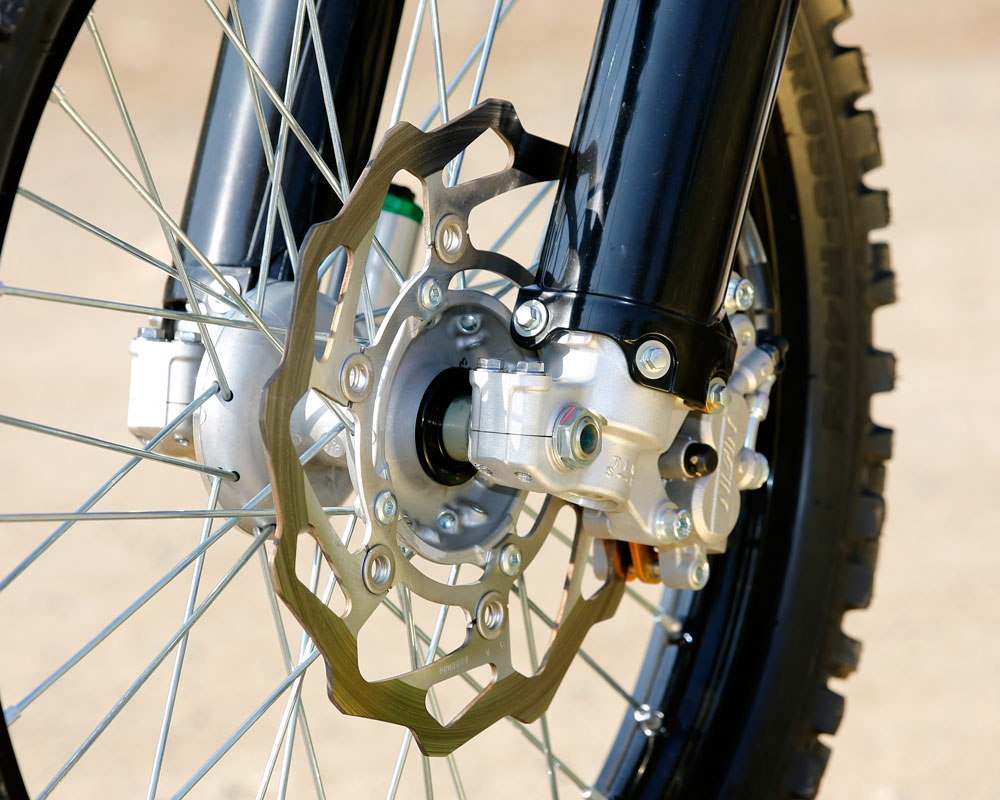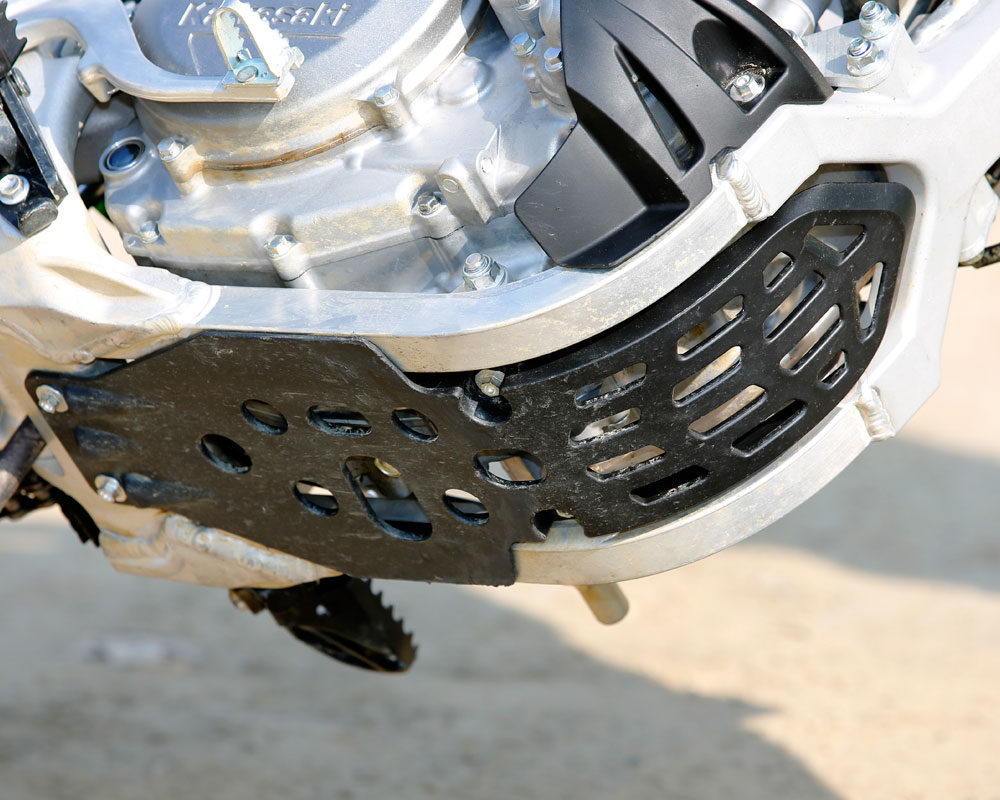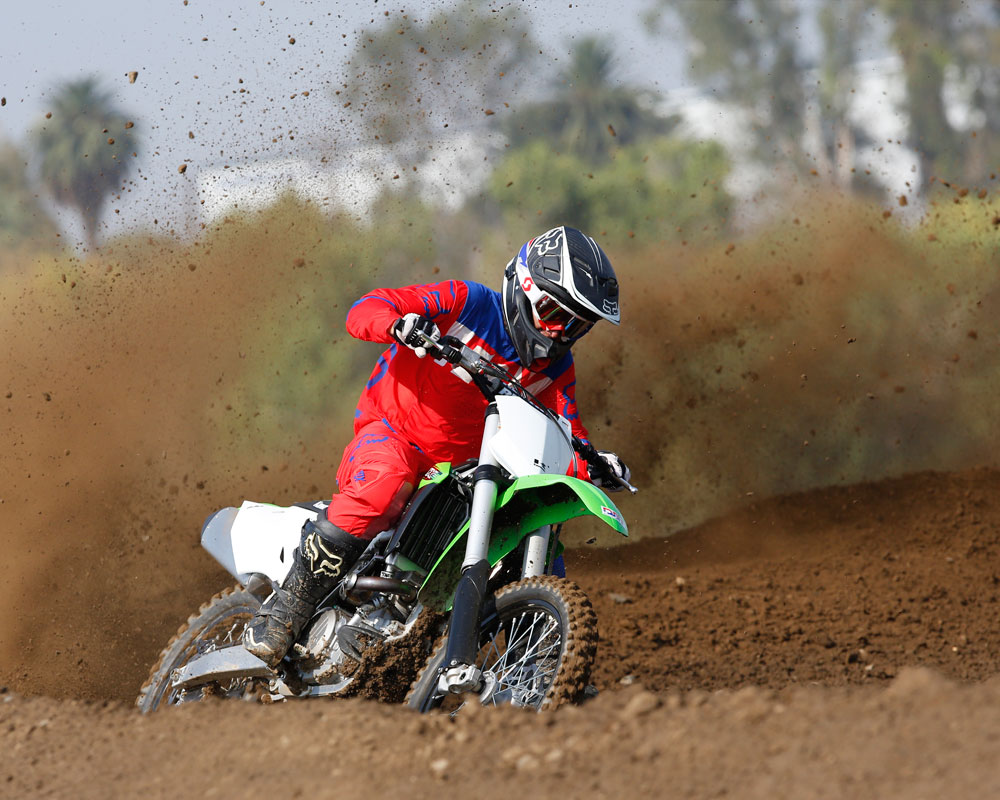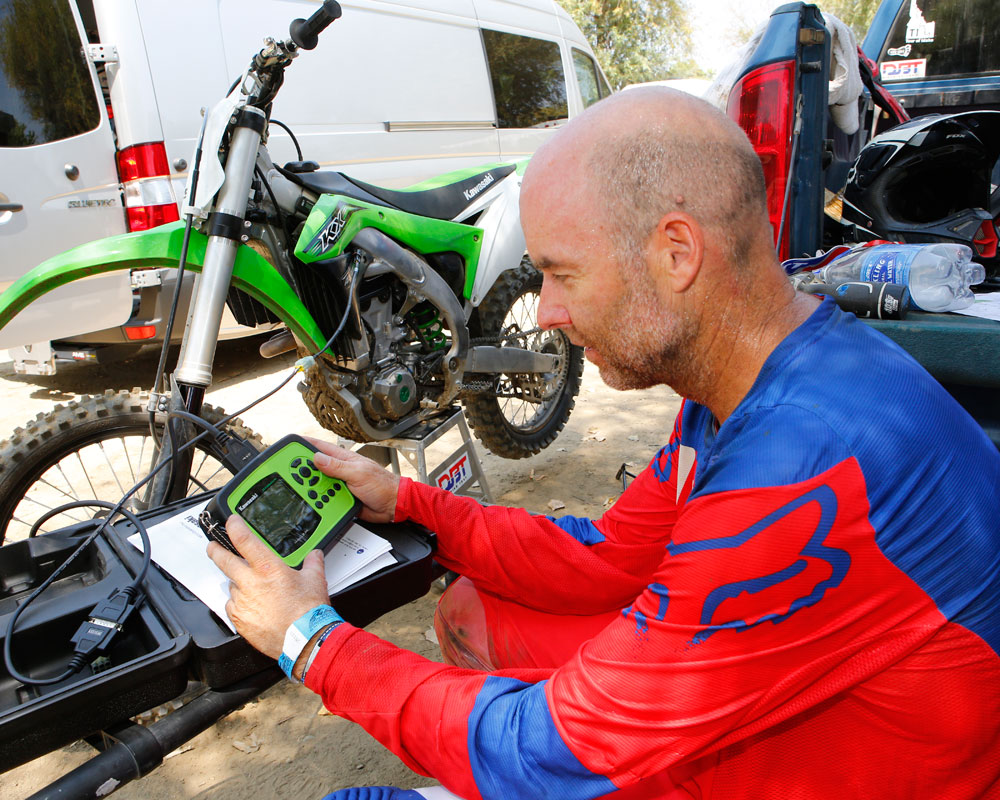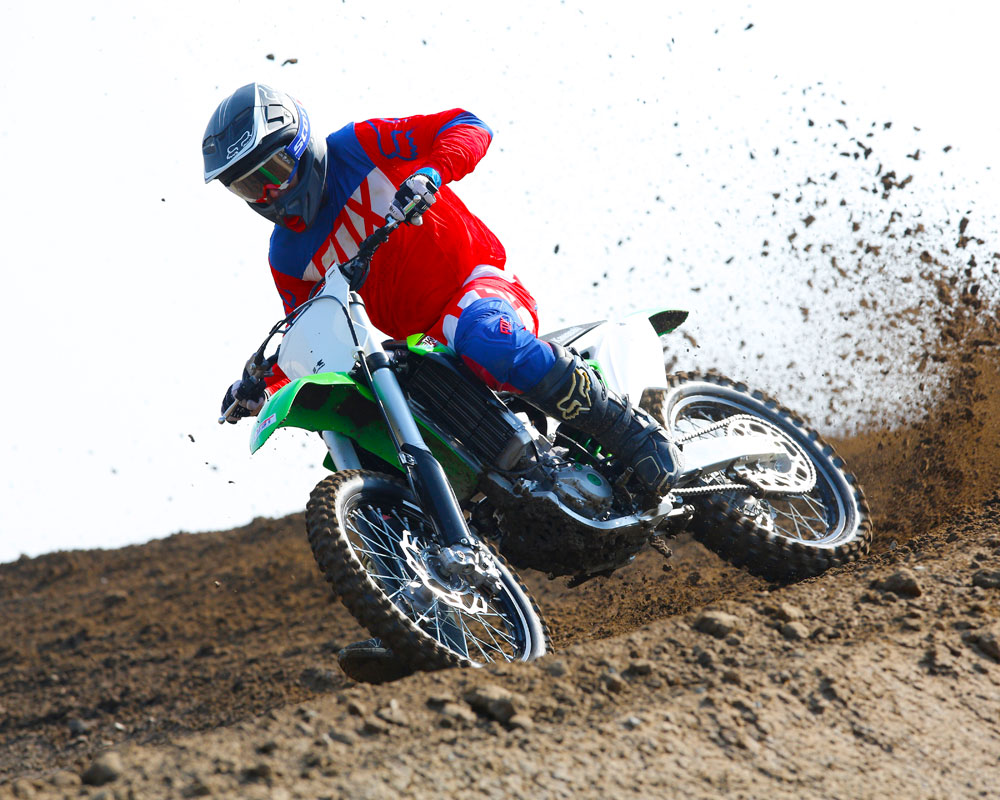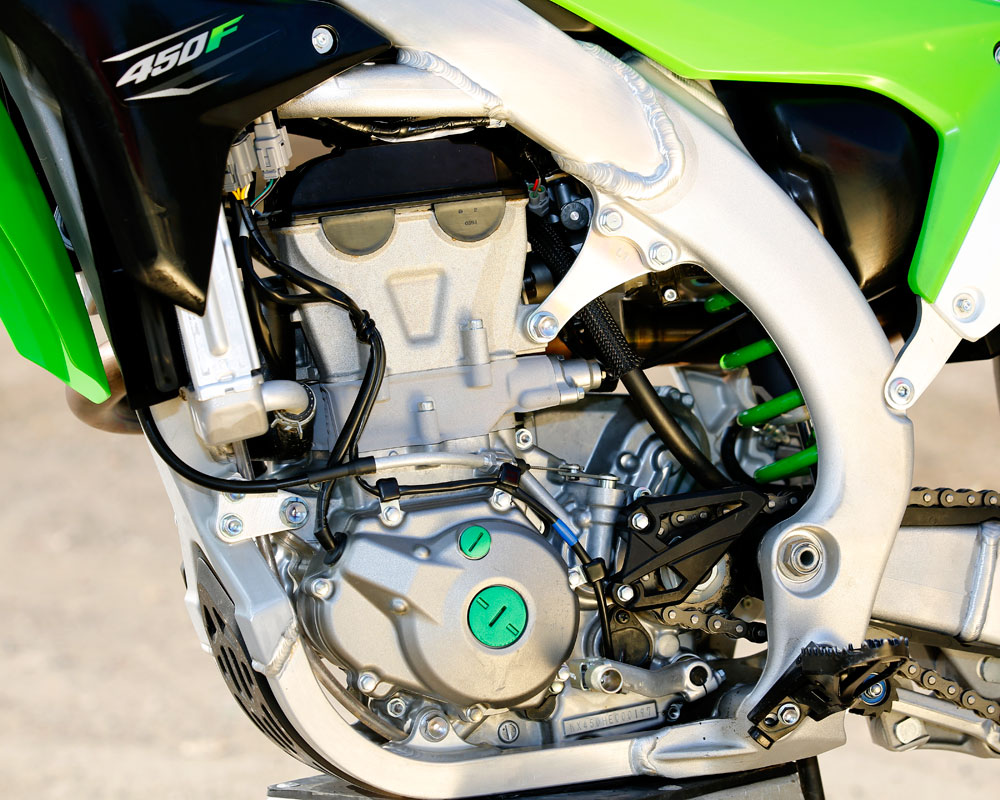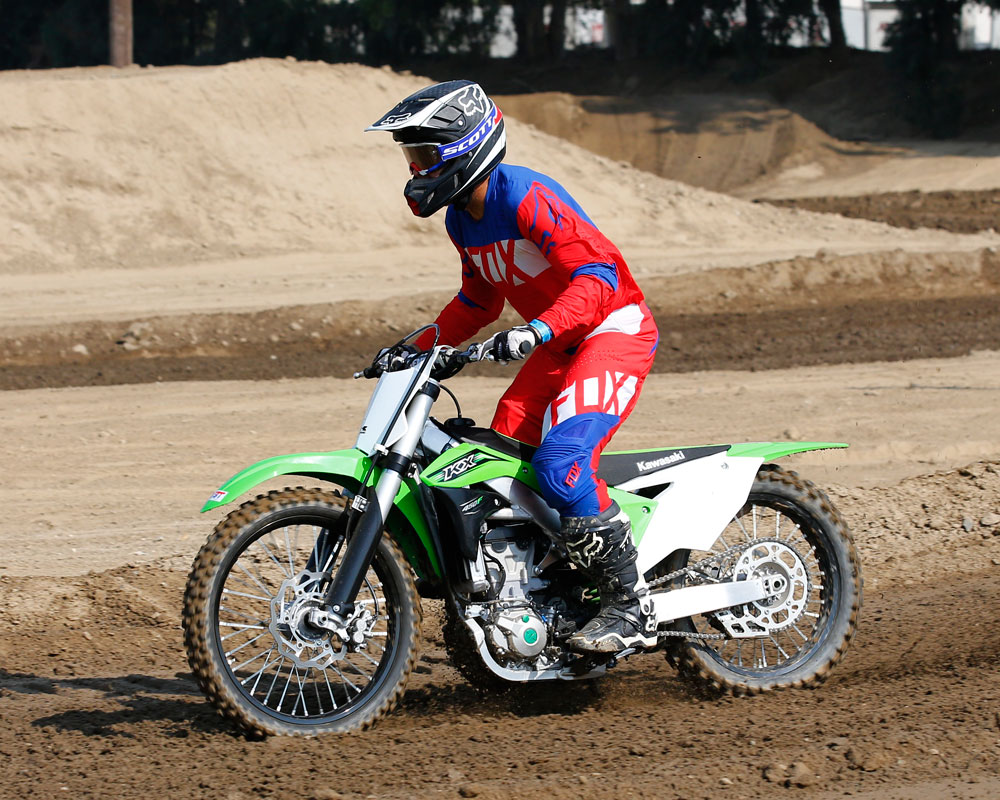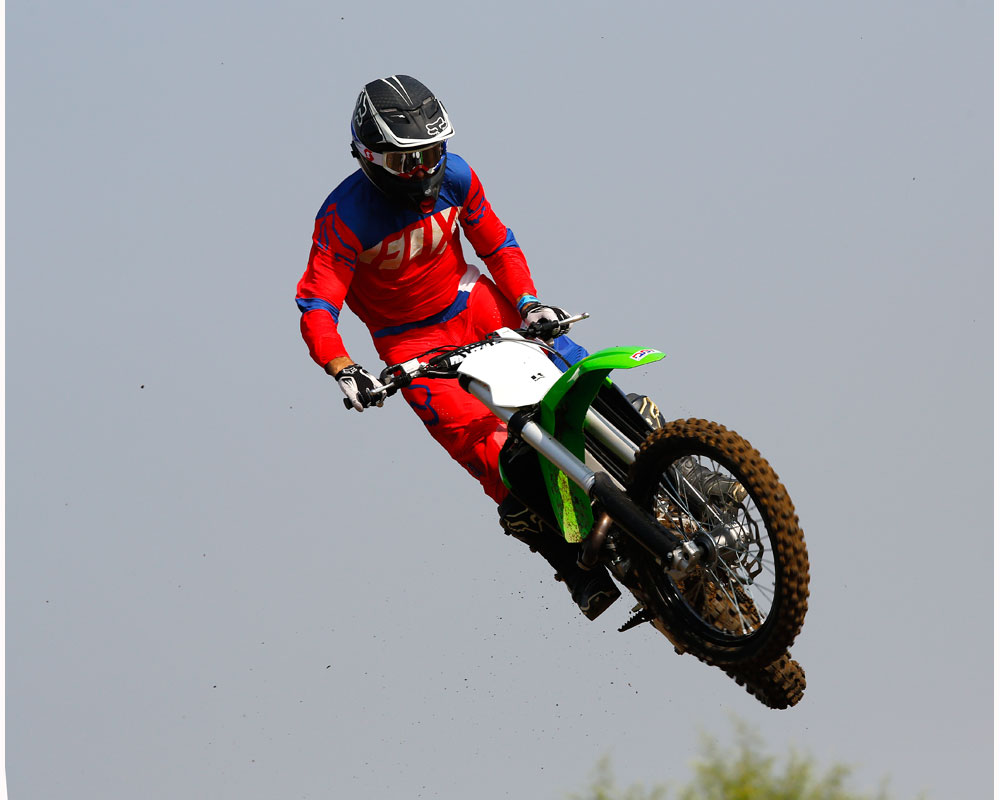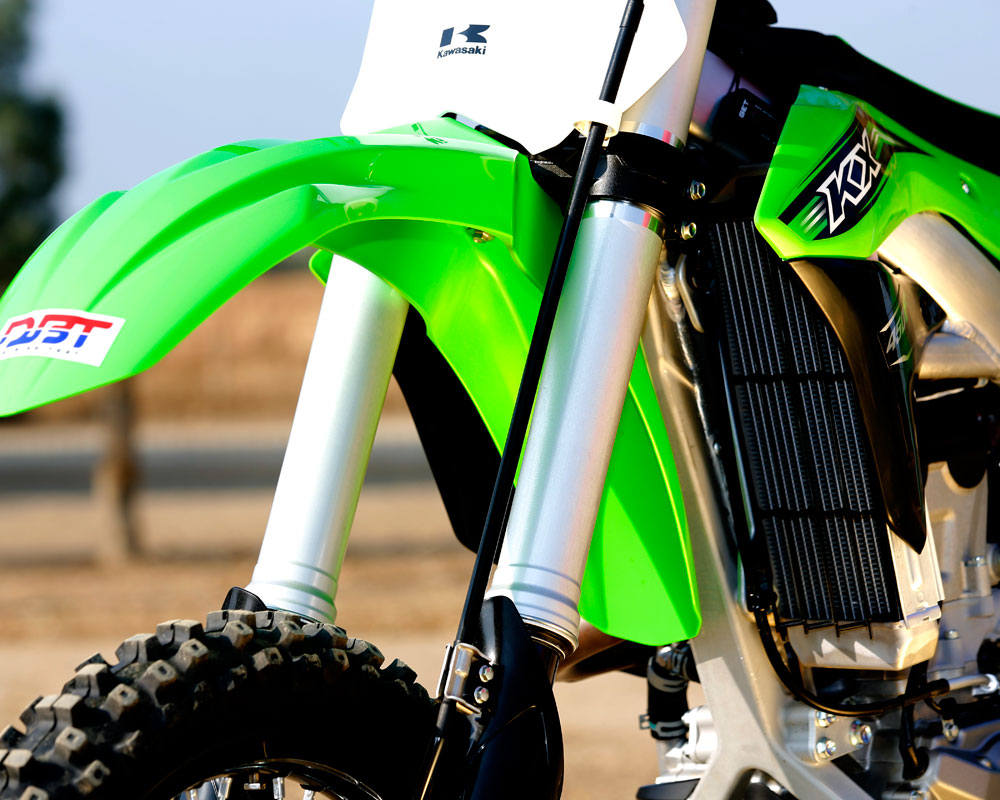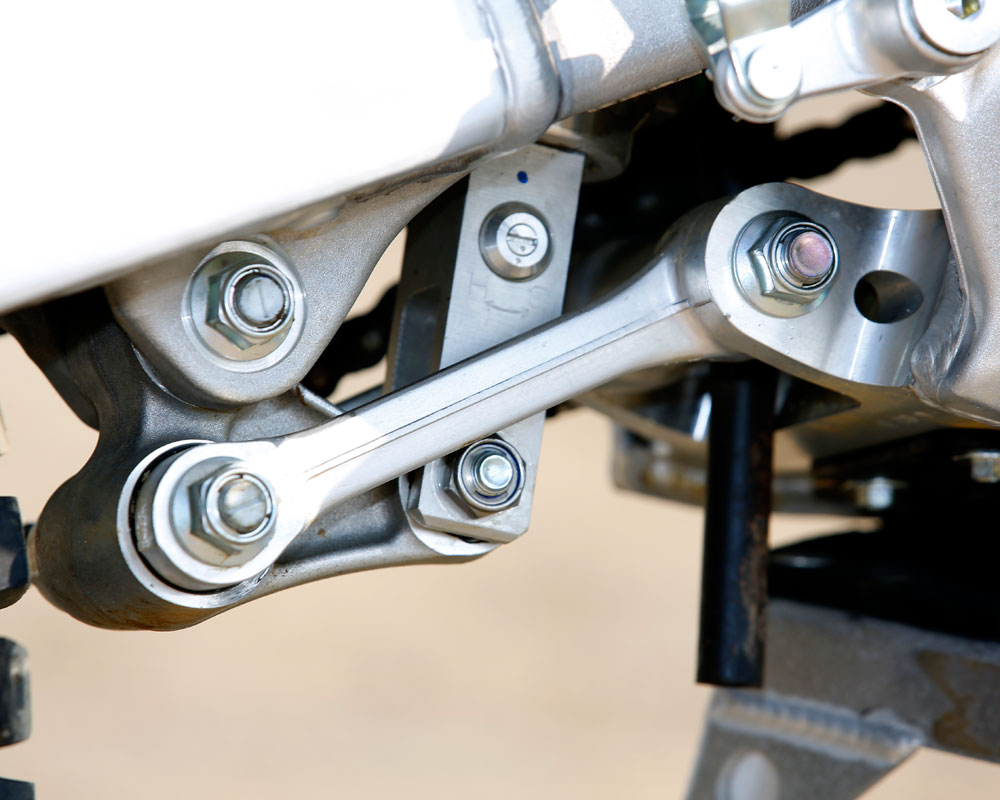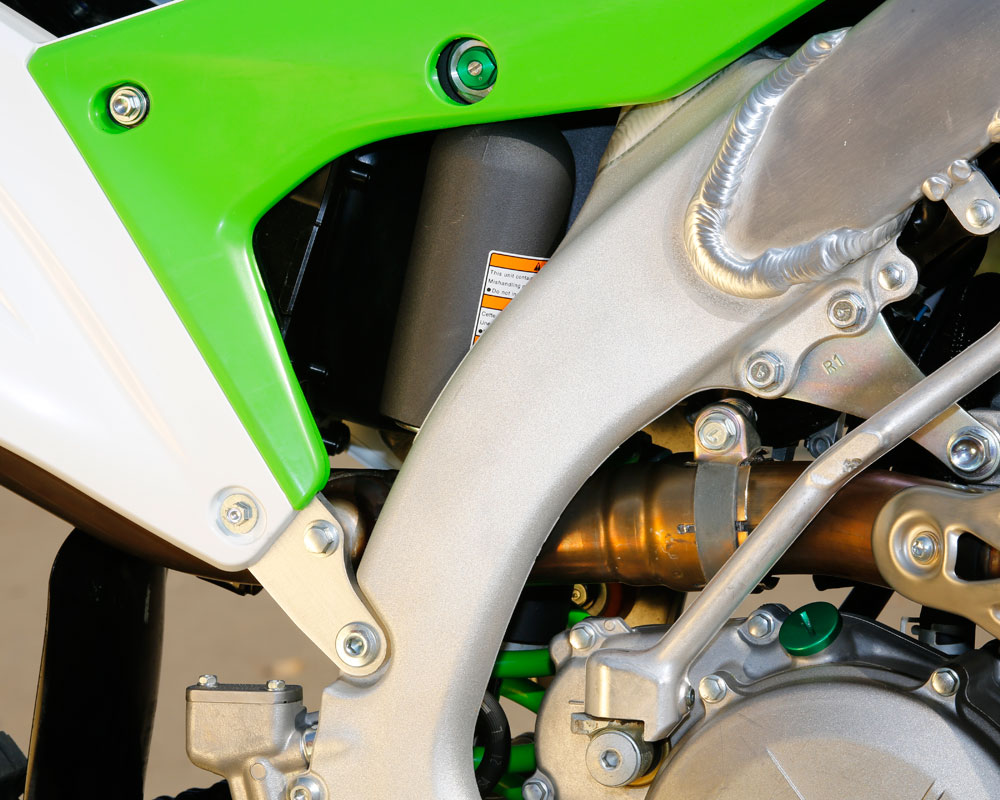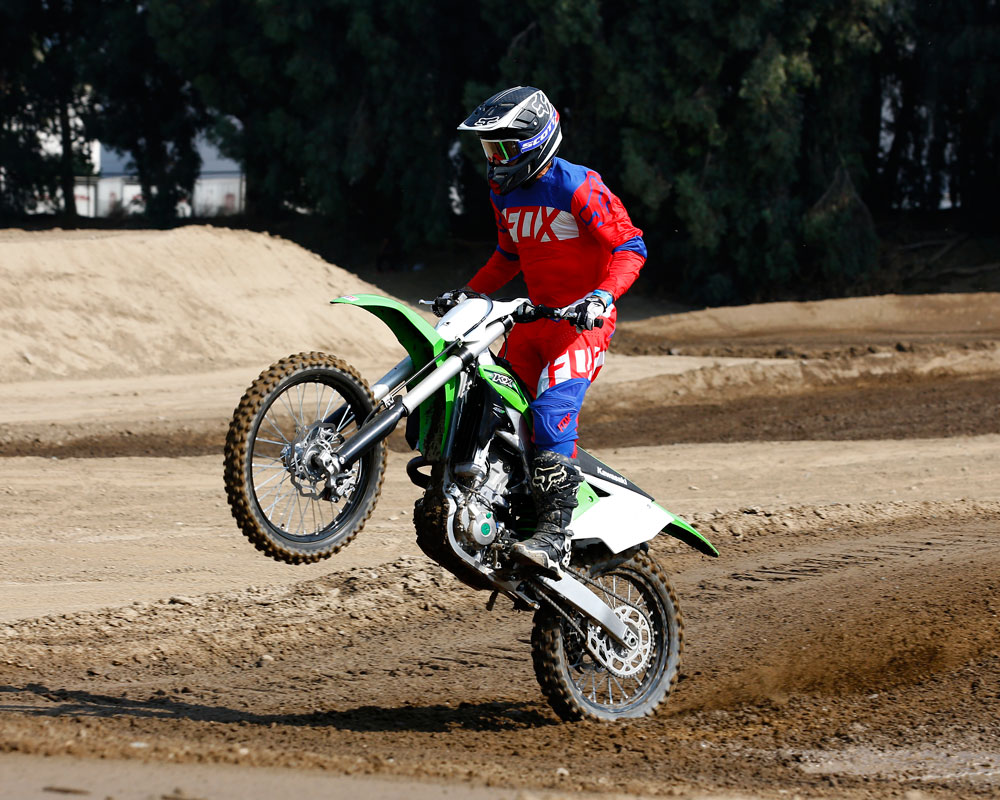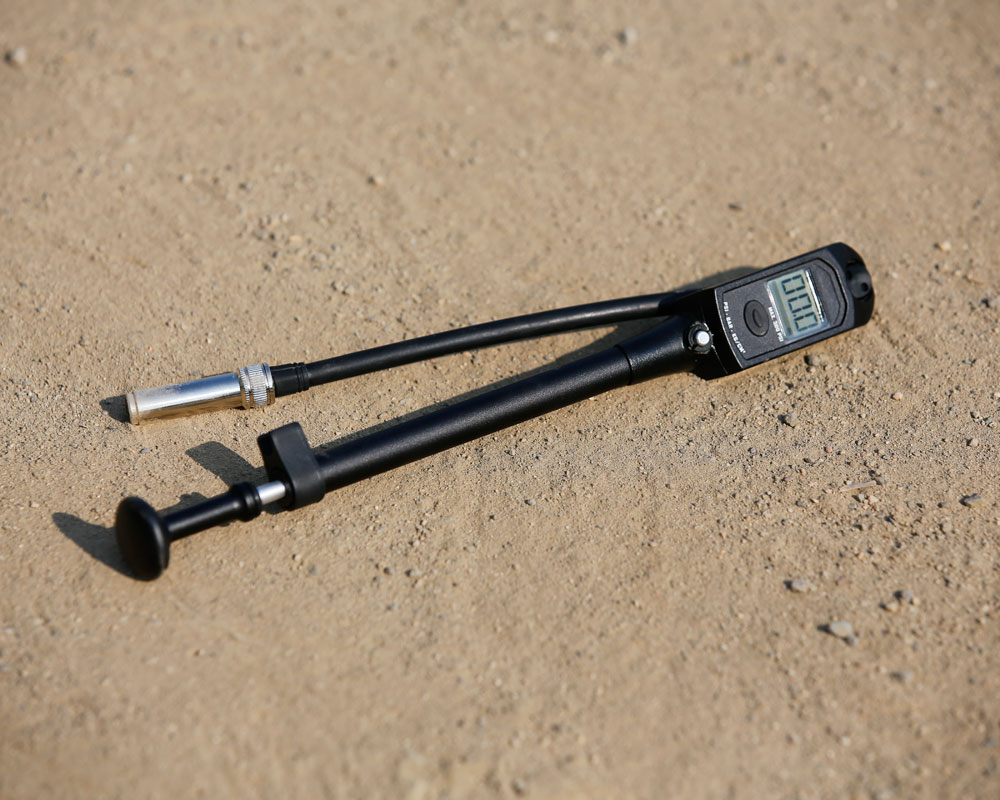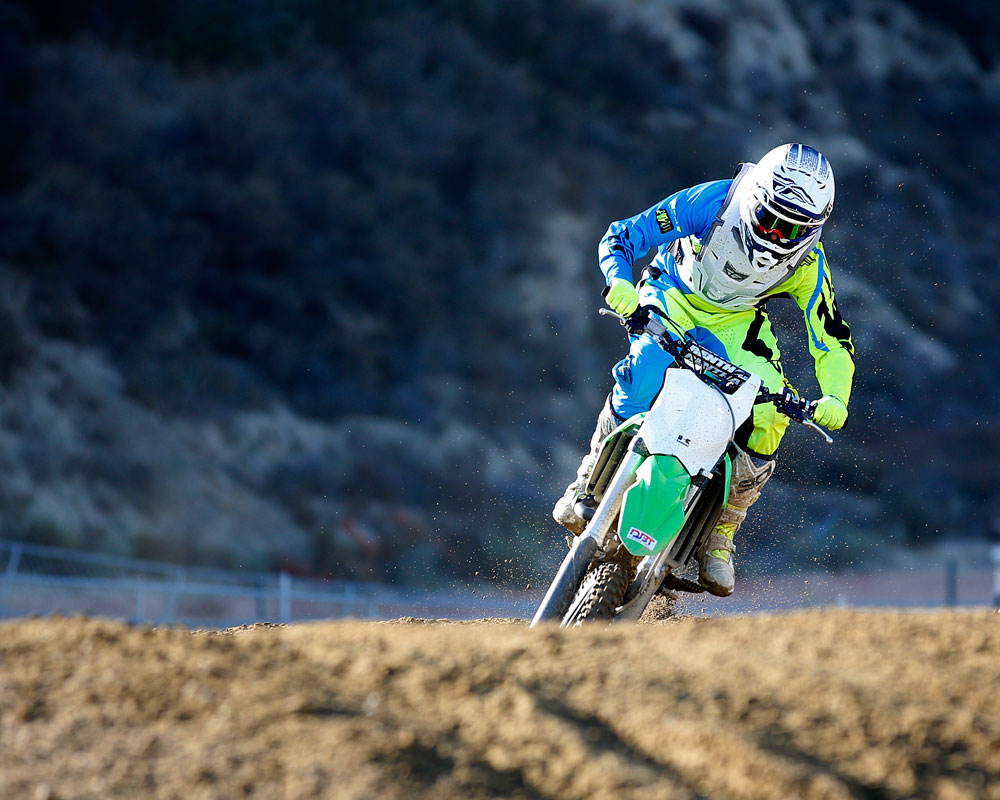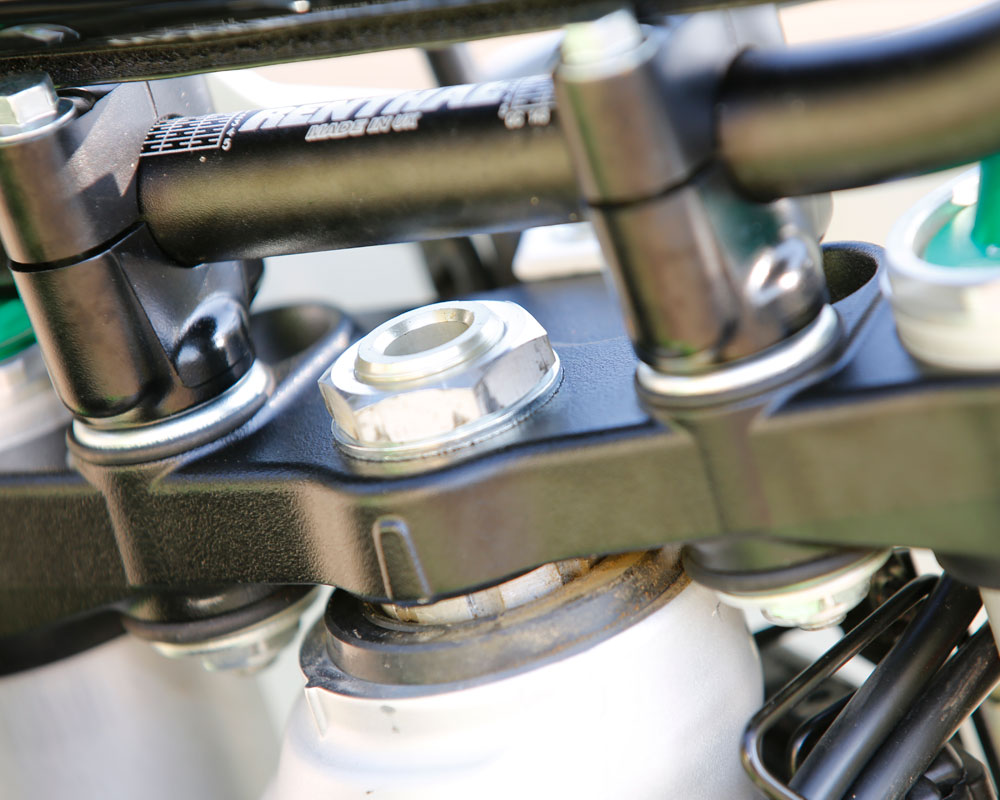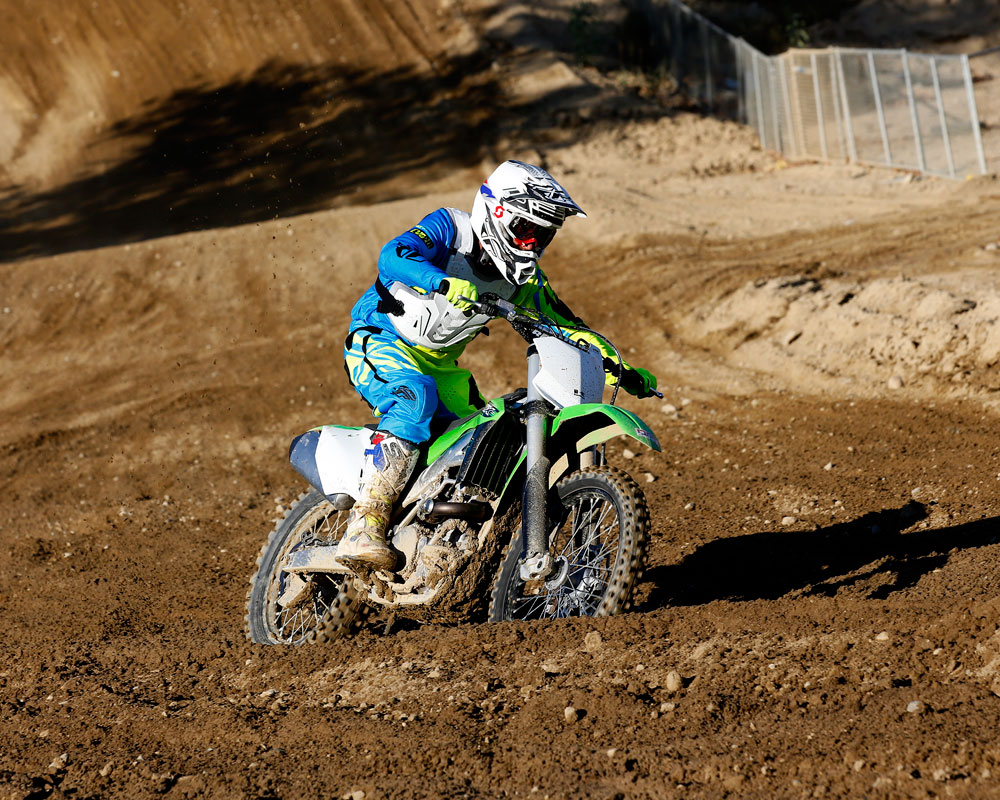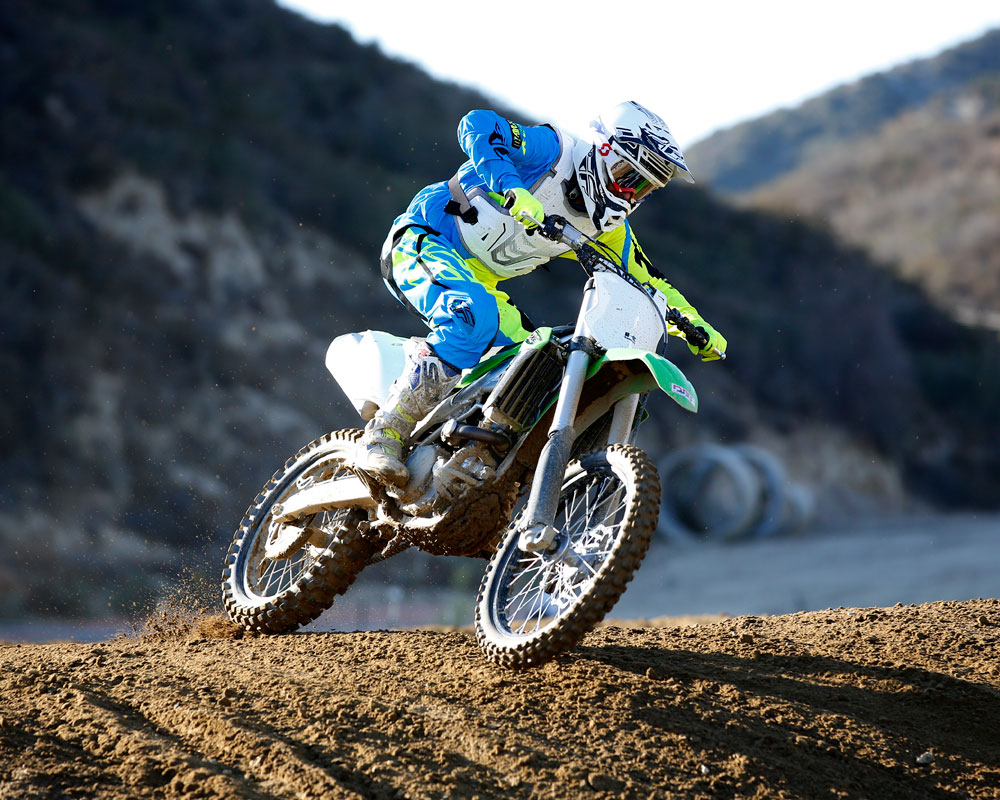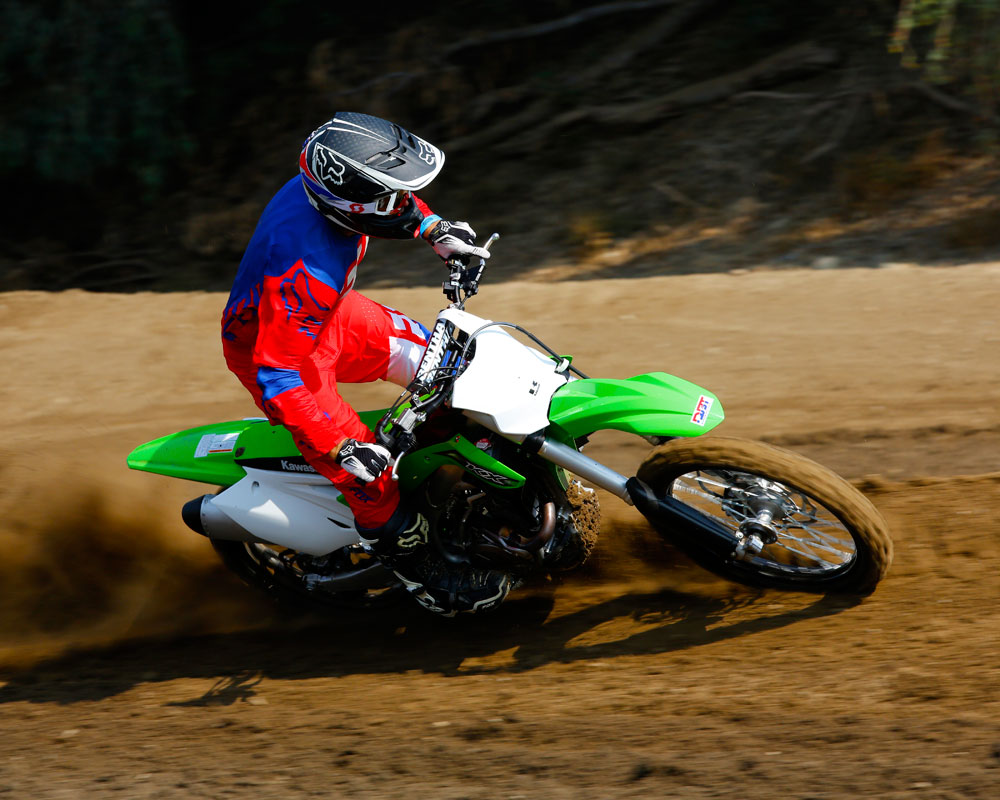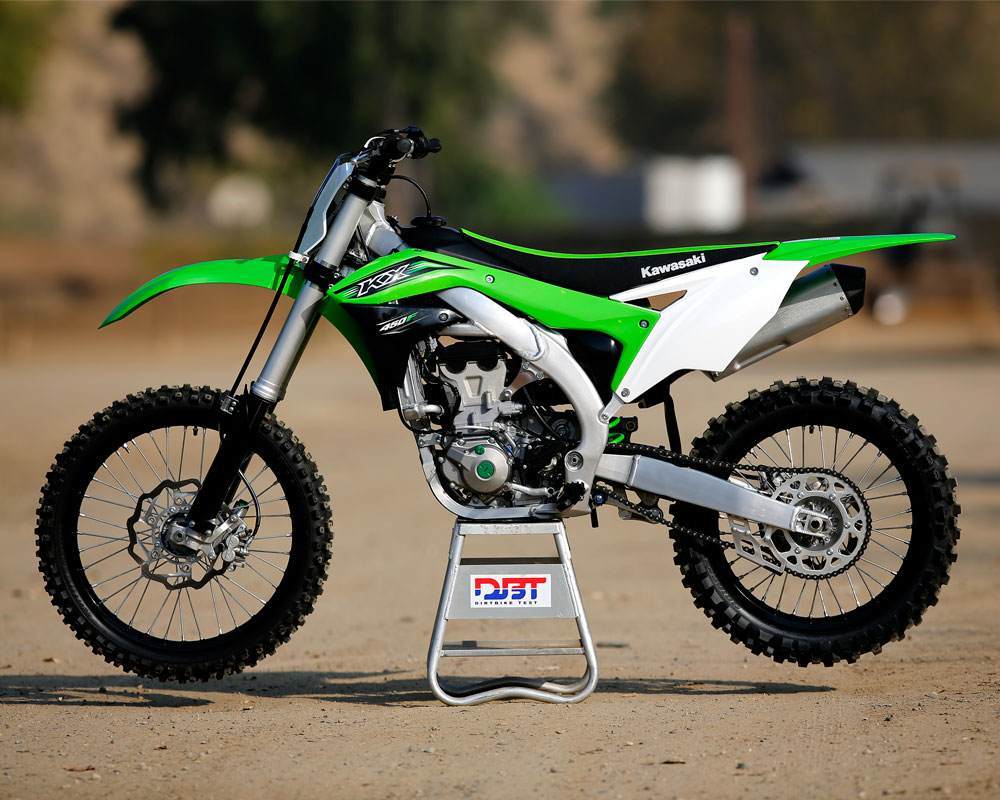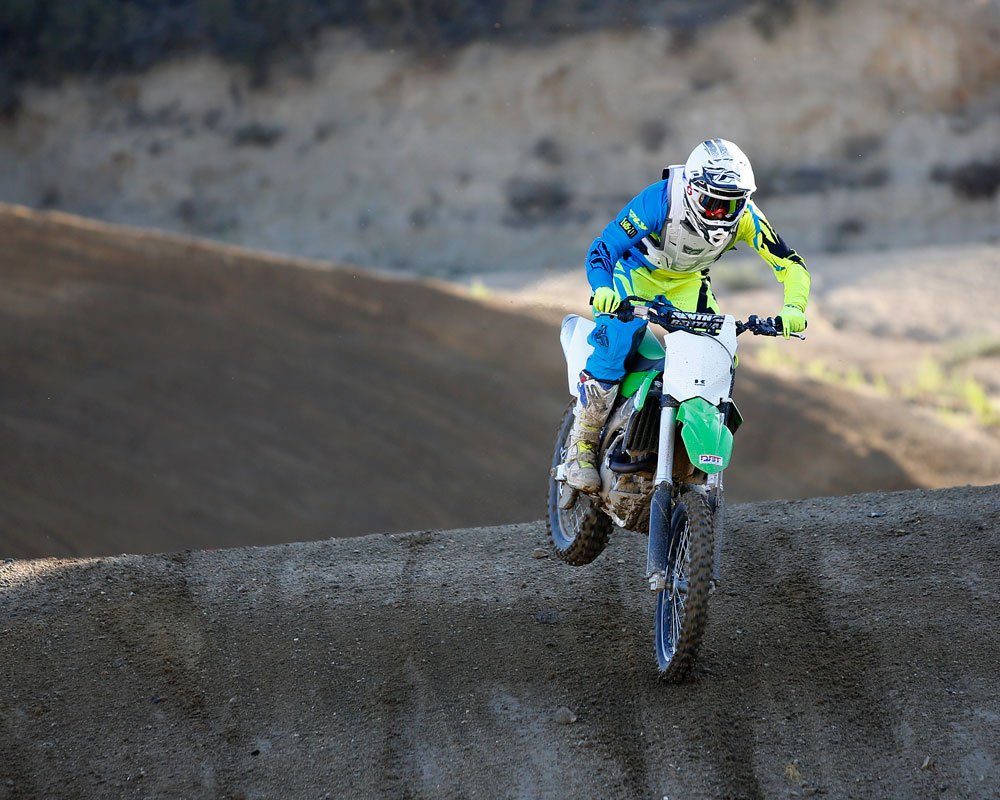2016 Kawasaki KX450F
The New Green
MSRP: $8799.00
- A very synchronized package--the bike's parts work in tune.
- Smooth and powerful engine that gets it done and still has character.
- Great turning with excellent stability.
- Does not have the parking lot power hit that a lot of riders felt made the bike feel fast.
- Don't let your ears tell you if this bike is fast. Louder is not faster!
- The chain/sprockets and wear pads last as long as the oil in the engine.
Introduction
- Yes, I'll have the all-new KX450F motorcycle, hold the wheels and suspension, please.
If it aint broken, why fix it? Sometimes this works and sometimes you get left in the dust. For the past few seasons the tried and true Kawasaki KX450F was on top of its game or pretty close during head-to-head shootouts. The KX was a workhorse; raw power and an easy to ride chassis that was 100 times more stable than the Chinese economy. No it was not the lightest, most flickable and was not on rails when it came to turning but it just worked--the engine often made up for any shortcomings. The bike was almost considered old school due to the chassis’ larger feel but it was still a favorite to many.
Enter 2016, Kawasaki removed the suspension and the wheels and drove an all-new motorcycle under a very short list of existing components. The theme for 2016, put the KX on a massive diet and makeover at the same time. Kawasaki must have hired Aldon Baker to train the KX because this bike feels light just lifting it on a stand. The question we have all been asking, did Kawasaki retain some of the traits loyal KX owners have raved about for the past few years or did they completely change directions like Honda did from 2008 to 2009? The answer is yes and no and kind of and sort yes and no, but you will see it all works out in the end.
Changes
- What isn't new?
- Lighter, thinner redesigned engine.
- Slimmer and lighter framer.
Like we stated above, it is not what’s new, but what is left of the older KX450F. And that answer is not a heck of a lot. Yes it is still green and has the same suspension and wheels and maybe rear brake setup but from there the slate is clean.
What is really new is the lack of girth on the new KX. Yes we have seen manufactures talk about saving grams and ounces but Kawasaki can say they lost pounds and lots of them. With a claimed 7.5 pound weight savings over 2015, this is considered a big jump at this current time. The '16 KX tipped our scales with a full tank of fuel at 240 pounds.
The engine makes up the lions share of the weight saving, 4.4 to be exact. The powerplant is just that, all new from the cases up. The cases are slimmer and lighter and the oil pump has been located to the right side. The overall goal was to build an engine that delivered better mid and top but with a smother delivery. To meet its goal Kawasaki offset the crankshaft 8.5mm to reduce friction, revised the shape of the crank and lighten the balancer and drive gear by 3.3oz. The cylinder head has been altered with new port shapes and a special coating on the intake valves. The piston is new a bridged-box design with a revised crown to accommodate the intake tract changes--now with a compression ratio of 12.8:1. New 36mm Ti intake valves and a lighter cam with revised timing are also part of the head package which appears very similar when viewed from the outside. Inside the transmission is a new layout to save weight but with larger input and output shafts, yet thinner to save over 9oz.
The Fuel injection body is also a more compact along with a smaller fuel injector. Behind the FI unit is a lighter air box design that eliminates the use of steel parts for more weight savings. Heading even further back new air intake channels are placed in the rear fender to help the machine breath and sound better. Out the other end of the power, the exhaust is new with a resonator built into the header with a claimed noise reduction of 2db.
All of the FI and timing settings have been tuned to match the engine. And now Kawasaki offers a handheld calibration kit that allow owners create endless fuel and ignition combinations themselves or load in pre-programmed settings depending on rider needs. It can be done right at the track and without the need of a laptop computer or even paired with a laptop for extra features. The kit is not cheap at $699 plus a $30 cable.
The frame also went on a diet losing nearly a pound along with a new slimmer design. The down tubes are now forged to increase rigidity and the frame width is now 6mm more narrow at the knee area. The overall goal was to improve front wheel tracking and create a lighter handling feeling and make the KX easier to change direction on. The swingarm is new and 7.8oz lighter but redesigned to increase overall torsional rigidity for improve rear wheel traction. With the frame changes comes new bodywork as well. Newly designed fenders also shed weight and engine covers complement the overall look of the bike. The ergonomic layout has 10-degree V-Shaped radiators help slim the feel of the bike by nearly an inch and a half up front without affecting cooling capacity. To keep up with the Joneses, Green upped the game to a 270mm front brake rotor to better slow down their 7.5lb lighter racer.
Like we said above, the Showa SFF-Air TAC for returns this year with revised settings, thinner lower fork tubes and low friction fork seals. The shock also received new settings, 53Nm to 52Nm shock spring and a new shock linkage ratio.
Returning are four-position handlebar mounts, adjustable height foodpegs, launch control electronic start ignition setting and swappable DFI couplers to quickly change the engine timing/FI settings without the need for the calibration tool.
What does this all mean? Pretty much nothing on your old KX fits the new bike and the 2016 is a totally different motorcycle on paper.
Power
- Smother does not mean slower!
- More over-rev and longer lasting top end.
- Sound output lowered to a reasonable level.
One of the two big changes a rider will feel right away is the change in the power character of the KX. First off the KX is much quieter from idle and especially as the bike picks up revs. This was a sore point and riders should be a little more concerned of the impact noise has on keeping tracks open. Kawasaki took note and we applaud them. Along with this the new engine makes smoother power that is not as abrupt or sudden as it has been in the past. Where the old KX hit like a load of bricks then fell a little flat before hitting again and whaling through to a noisy and flat top end, the 2016 KX now comes on earlier with a little less steam and a lot less hit so it is way easier to manage and ride. Now the pull is powerful, progressive and takes a little longer to go through the spread finishing off in a decent top end surge. The KX has never been the most powerful bike in the class although your ears and the jerk you'd get off the bottom might have confused you into thinking this. Now the power feels just like "plain wrap power" with no surprises, the motor just does work. With one of out testers having ridden a factory KX450F a few years back the power amount and character seemed very familiar.
The output isn’t by any means weak or slow, it just isn’t as aggressive as before and isn’t such an in-your-face, tire spinning, back end sliding monster. Now the KX gets traction and pulls so you are not forced to use the clutch to tame it. Rolling on the throttle will move you forward fast enough that you do not have to use the clutch. Cranking open the throttle, which in the past was a waste of time and tire life will still have the bike exploding forward unless you are 240 pounds and taxing the horsepower to weight ratio.
Our bike was very lean and was popping and backfiring on deceleration, we even experienced detonation. The "less aggressive" or "richer" DFI clip can help but it was not as good as the next option. We got our hands on the calibration tool and started to play with this. We found a few solutions to both the lean condition with a generic richer map (5% increase in fuel everywhere) and a map built to boost the torque feel that gave a character much reminiscent of last years powerband if that is what you are after. The ability of these complimentary tuners to change the delivery and style of power is amazing and so good that almost any of our test riders will take the time to build maps for different conditions and tracks. Once a rider understands the way the tuners can change and customize the power delivery, they begin to expect this precise performance. $700 seems like a lot but it is like buying 30 different pipes that you can change in a minute and not get your hands dirty or burnt.
Adding the fuel also let the power last even longer through the spread and was excellent any time traction was limited. But when raw power was needed, for instance at a loamy Glen Helen running the full National uphills, then adding some ignition advance was approved by everyone. Kawasaki had a "torque feeling" map loaded in our tuner and we built maps based off of that for different riders and conditions where there was traction.
The clutch action is light on the pull and the feel is good though you can get it hot with too much slipping. Ours was still fine after 10 hard hours. Shifting was great for all but one of our riders who seemed able to find a false neutral between 2nd and 3rd on downshifts. After an oil change (and the oil was cooked) this issue went away. There is also a tight turn in the routing of the clutch cable and some flex in the cable which isn’t an issue for most. But compared to the precision of a hydraulic unit we notice this.
Suspension
The suspension may be the least changed thing on the KX and that may be a good thing because the suspension, specifically the air fork, has been the talking point of current motocross bikes. It can be argued that even with one of the better air forks out there the KX has suffered in comparisons since going this direction, which is strange since the actual performance is improved in a lot of ways. It is much much lighter and gives the bike a overall lighter feel. The initial bump damping is also better, rivaling even the KYB SSS spring fork in the small stuff. Then there is the bottoming resistance, which overall has been bettered. All this is true for the current KX--with one big overshadowing statement that has to do with most of the current air forks out there: If you can’t find a setting to get your fork to work, you likely have not tried hard enough. Kawasaki recommends a very good baseline setting that is a proper starting point for all riders we used. The KX even comes with the air pump you need to check and adjust the fork.
We check the fork pressure (just like tire pressure) before every ride and so far we have noticed that temperature will change the pressure more than the bike sitting for a time. Our bike never lost noticeable pressure, even tied in a truck for a couple of days. Of note is that the volume of the balance chamber (the adjustment on the lower fork reservoir) is a small volume and it drops 2-5 PSI upon checking it. The main spring chamber and the outer chamber especially are not so picky and have more volume to work with. Enough about the specifics, how does the suspension work?
Excellent and with little fuss. The 2016 KX450 is one of those bikes riders can just jump on and ride. It isn’t too critical about exacting the ride height though we stuck with 100mm as a baseline. The bike is light on its wheels but it does not dance, it feels planted and connected to the ground without being harsh or chattery on the bumps. You feel just enough of the ground to know what the tires are doing underneath you. The bike likes to squat down in the back a little, the softer rear shock spring is helping this feeling but it does not pack down, it remains active. Then it bottoms, both ends where you’d expect with good control for an average speed rider.
We played with the suspension at a few tracks and found it could be set for riders up to 200 pounds with the stock shock spring. Faster riders liked a little more pressure in the outer chamber of the fork to help with bottoming up from the standard 14.5 PSI up to 18 PSI as long as the track was not too choppy, then that increase was less. Experience tells us that adding a little oil will also achieve better bottoming control as well.
We could fine-tune for feel with clickers on both ends and it was really just that. The KX is one of those bikes that is not particular and didn't need changed track to track or for changing conditions during the day.
Chassis - Handling
The second standout feature of the KX is the new found light handling feel. The weight may read 7.5 pounds on the spec sheet but it feels like 20 pounds when on the bike. This 450 has more 250F characteristics than you’d expect, especially off throttle. Then you get on the gas it quickly reminds you it is a 450 but still having agility and control that was not present on the KX450 of old. It is a balance between having a great chassis and a motor that is much more controllable. The old bike’s best trait was that it was always spinning and sliding so there wasn’t so much a concern about how it handled, you were along for the ride. Now you are riding the bike how you’d like, even if you want to pin it and hang on for the ride.
With the light feel comes a very planted front end that steers how a motocross bike should. There is average weight in the handlebars and the bike does not lean in too quickly nor is it too slow. It lets you know if you are pushing it and tracks all the way through turns, wheels in line or sliding depending on how a rider likes it. Of note is the use of Bridgestone M403/404 tires which was complimented by most riders and they even lasted much longer than we expected.
Then there is the stability which is very good as well. We won’t call the KX the most stable bike but it isn’t unstable either, changing the attitude with ride height can swing the feel as needed. Using the shock’s high-speed compression in quarter-turn increments works wonders here.
Jumping the KX and getting it in the air is another place the weight makes a difference. You can feel things like the balance of the wheels and vibration of the engine--it is so feathery not to mention much easier to whip around of that is your thing.
The thinner bike is easier to move around on and especially get forward on. Angling the radiators does make a difference here especially when putting your leg forward in turns. Getting back there is no in interference from anything that bulges.
The oversized front brake brings the KX into the norm for brake strength and feel, it is noticeable and appreciated, especially on a bike this fast. Ditto for the rear which isn’t too strong or overpowering and did not fade even with some brake dragging abuse.
Adjustability is another area Kawasaki likes to brag about even going one step further than other manufacturers. With adjustable footpegs in addition to a four-position top handlebar clamp the bike can be altered. We did not feel the need to move the pegs downward but have heard some riders really liked the lower position even if they also move forward at the same time. The bend of the handlebar fit most riders as did the lever position and bends. The quick adjust clutch also makes mid-moto adjustment simple.
Conclusion
- The KX450F has the "package" right.
- Minor durability issues but the aftermarket will handle it.
Building a better 450 is a tough thing to do, especially when you have been on or near top for so long. Refinement is the safe path, big changes involve risk. Plus there is the looking into the crystal ball and predicting the future preferred traits and characteristics a few years ahead when you are setting your development goals. Kawasaki has been on point with both of those targets in the past and we think they have nailed it with this bike as well.
Working on the bike it is obvious Kawasaki addressed a few concerns about small parts durability and at the same time let a few slide. The seat bolts now pass through the subframe in elongated holes and into fasteners built into the seat base. Other hardware has tapered ends to align the threads into their spots. We know it is a good idea to put some grease or anti-seize into the radiator shroud bolts as they can stick and spin the plastic encased fasteners. The new longer side panel is a little flexy near the knees/seat area but did not hook on anything for how loose it is. The green plastic seems a little more prone to going white from flexing and bending.
Then there is the chain guide and wear pads. We got all of 7-hours out of the stock set before they needed replacing. Even the chain stretched a noticeable amount more than we expected. There are options for the chain guide (Pro Circiut makes a nice carbon fiber cage with a much harder plastic material but it isn’t cheap!) and swingarm protector that will definitely last longer.
The basics of maintenance are pretty simple, changing the oil and cleaning the air filter. If anything learning the twist and spin of getting the air filter out and in from between the narrow subframe rails takes a little time.
Lighter is always a good thing, especially when you don’t mess up the handling. The KX450 does that. Having the most power in the 450 class is easy but making it rideable is the trick. The KX450 does that. Getting the whole bike to work as one is the clincher and the KX450 is a master of that. In reality there may not be any one area the KX450 stands out at being the best in individually but as a package it is one tough bike to beat.
Recent Product Tests
What Others Said

http://motocross.transworld.net/features/2016-kawasaki-kx450f-first-impression/#uMMH4OrDZDcfmio5.97

http://www.dirtrider.com/2016-kawasaki-kx450f-first-impression-review

http://www.motorcycle.com/manufacturer/kawasaki/2016-kawasaki-kx450f-review.html
Leave a Reply
